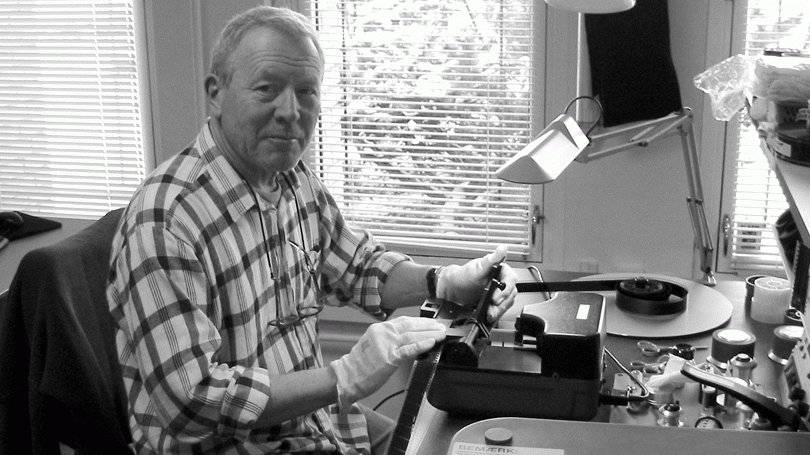Founding the Film Museum
In 1941, Dansk Kulturfilm decided to set up a film museum. Ove Brussendorf, who would become the museum’s first director, began to gather films and film-related material. The first films in the collection were cinema prints, on nitrate, deriving from international studio distribution. In the early years, the films were kept in two large boxes on the roof of the museum, on Frederiksberggade, Copenhagen. The collection quickly outgrew the two boxes and this was, of course, also a reckless way to store films, in terms of both fire safety and film preservation (more about decomposing nitrate film).
Improved collection oversight
In 1947 Filmmuseet changed its name to Det danske Filmmuseum and in 1950 the museum became a non-profit institution.
The films were moved from the roof on Frederiksberggade and into various empty wartime bunkers on the outskirts of Copenhagen. As a result, the museum soon lost track of its collection. In 1950, Ove Brussendorf moved the collection to some barracks on his summerhouse lot in Hvalsø (see photo above, photographer unknown, DFI Stills and Poster Archive).
In 1953-54, the entire collection was catalogued on index cards. A count of these cards reveals that the collection in the mid-1950s held 1,700 film items. This includes all possible duplicates of film titles, fragments, weekly journals, etc. The bulk of the collection was made up of foreign cinema prints, plus a number of 16mm prints. In 1946, Palladium was the only Danish film company that had donated materials to Filmmuseet. The film collection stayed in Hvalsø for 12 years.
Bagsværd Fort
The collection was steadily growing. In 1962, the archive was moved to Bagsværd Fort (see photo, photographer: Ole Brage). A climate control system was installed at the fort, but the system was never very good and for too many years conditions there were really far too damp for film storage.
In 1963, a big fire at the Johan Ankerstjerne film lab alerted the public to the hazard of nitrate film and in the following years the Danish Film Museum received a lot of nitrate negatives and prints. Today, the Danish Film Institute’s Film Archive is one of a handful of institutions in the country that store nitrate films.
Legal deposit
In 1964 the Danish Film Museum became a government institution. Before 1964, there was no legal deposit requirement for Danish films. Submitting films to the Archive was optional and, more often than not, worn-out prints were submitted. Luckily, most distributors and cinemas did deposit their cinema prints once the films were taken off the marquee. The 1964 Film Act made it a legal requirement to deposit a used screening print. That requirement changed to a new screening print in 1984, and an administrative decision in 1991 required film producers to deposit basis materials to the Archive, generally a master (also known as a duplicate positive).
Master material is a print, made from the original negative, of a quality that makes it possible to produce other security materials and new prints of the film. Films were not included under the Legal Deposit Act until 2005. Now, security materials and prints must be deposited for films that have received subsidies from the Danish Film Institute. For films that have not received DFI subsidies, two prints must be deposited and they may be used prints. See the current guidelines for legal deposit.
The Danish Film Institute
In 1996, the three Danish film institutions – Det Danske Filmmuseum, Statens Filmcentral and Det Danske Filminstitut – were merged into the Danish Film Institute. Today, the Film Archive is a DFI department, under Museum and Cinematheque.
In 1996, all the films in the collection were still being stored at Bagsværd Fort. Because the climate control system never worked satisfactorily, storage conditions there were far from ideal. After sustained criticism of the conditions at Bagsværd Fort, the 1999 Film Agreement finally rallied political support for new storage facilities. In January 2000, all the films, with the exception of the nitrate films, were moved to a new archive in Glostrup. Today, there are 3,000 sq m of storage space in Glostrup, including 1,200 sq m of cold storage.
The new Nitrate Archive
In summer 2007, film storage at Bagsværd Fort finally came to an end. All nitrate films were moved to the new Nitrate Archive in Store Dyrehave near Hillerød, north of Copenhagen. There, films are stored at minus 5 degrees Celsius, according to internationally recognised film storage standards. The Nitrate Archive was built inside an underground Cold War bunker that was divided into a lot of little rooms (more than 60), each containing 1 tonne of film. The division into little rooms is to ensure that only a limited number of films will be lost in case of fire.
The above photo shows the visible part of the Nitrate Archive, the so-called explosion hatches. There is one over each room and, if fire breaks out, the mounting pressure in the room will cause the hatch to blow and the fire will move upward instead of sideways into the other rooms.
